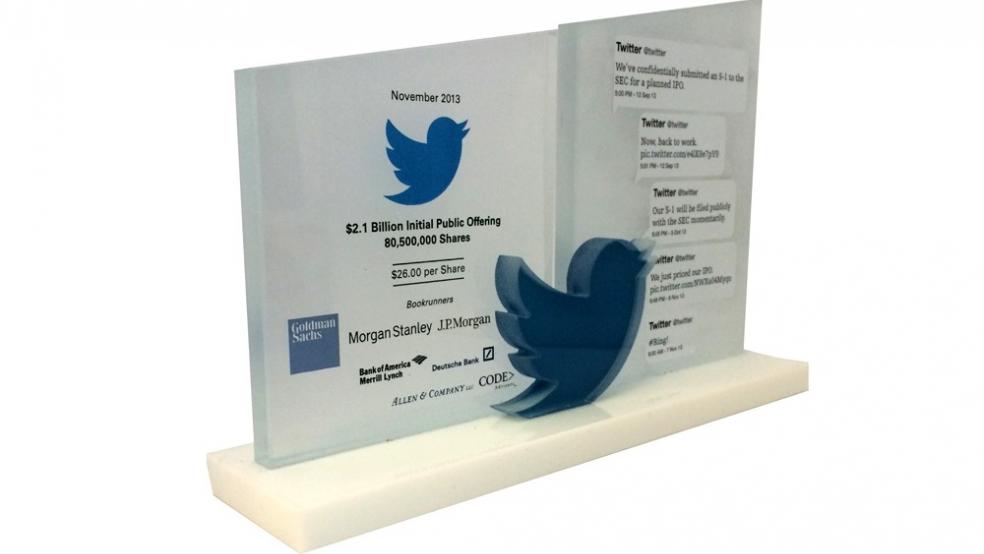Wall Street deal-making is in high gear this year. So far in 2014, investment banks worldwide have pulled in about $1 billion in fees from initial public stock offerings alone, according to recent data from Dealogic.
As of the beginning of March, private equity funds and other “financial sponsors,” like KKR & Co. and the Blackstone Group, had negotiated a record $19.6 billion in transactions so far this year, 50 percent ahead of last year’s pace, while the number of deals also hit a record of 64, close to double the figure for 2013. Meanwhile, mergers and acquisitions over the first two months of the year were at levels not seen since 2007.
If deal-making is back in fashion, can so-called deal toys be far behind?
Those toys aren’t so much playthings as they are trophies of sorts — Wall Street mementos of financial deals, doled out to top executives and bankers in commemoration of any kind of strategic deal, from a plain vanilla debt offering to a hotly contested hostile takeover.
Slideshow: 7 Hot Wall Street Deal Toys
In the wake of the financial crisis, companies and artisans that specialized in making the Lucite tchotchkes, also known as tombstones, struggled for survival in pretty much the same way that the banks who were their major customers did.
Some of those financial giants had spent hundreds of thousands of dollars a year for the trinkets. But five years ago, as the number of deals plunged so did the willingness of banks to pay up for deal toys. JPMorgan Chase did away with them altogether by 2007, according to a Wall Street Journal post-crisis survey of the business.
“I don’t think the business will ever come back to pre-crisis levels,” says David Parry, director of digital strategy at The Corporate Presence, one of the biggest players in the deal toy industry. “But in the last year or so, we’ve seen an increased interest on the part of banks, going back to their original purpose: using ‘Lucites’ to highlight their creativity and accomplishments and serve as a way to brand the bank.” Revenues are up 23 percent from this point last year.
Deal toys evolved in the 1970s as banks sought a more lasting alternative to the then-ubiquitous “tombstone” advertisements in papers of record like The Wall Street Journal. These served a dual purpose – they made a transaction a matter of public record while promoting the achievements of the bankers who had structured or negotiated it.
The ads, though, had little to no lasting value. Most newspapers ended up tossed in the garbage after a day or two, and even if the banks wanted to preserve a particular tombstone — well, there’s nothing very visually appealing about a scrap of yellowing newsprint. The idea of giving out pens and Tiffany carriage clocks was a nonstarter. “You can only give out so many clocks before it gets ridiculous, and pens – well, people lose them or they get swiped,” says Parry.
Related: How Wall Street Turns Its Pups into Wolves
The “Lucite” was born to address this; the first deal toys did no more than encase those newspaper tombstone adds in a solid block of the transparent plastic-like compound, developed in the 1930s and then used to make aircraft windows during World War II. “It was a gift that was a tangible reminder of the character of a deal; its impact was a lot more sustainable,” says Parry.
Before long, the squares and rectangles of those early deal toys became increasingly complex. One of the first to take a different shape was a triangular prism, designed to celebrate the completion of the heated battle for control of RJR Nabisco in 1989.
The creative floodgates were open wide. The Corporate Presence designed a toy for a gaming company featuring a riverboat casino afloat. Lehman Brothers handed out deal toys shaped like a George Foreman Grill to celebrate a financing for the company selling wares under the former boxer’s name. At the same time, not-so-clever references abounded: a client at Apollo Capital, a buyout shop, suggested a design that involved a statue of the Greek god of the same name. If the deal involved a pipeline, you could pretty much imagine that there would be a conical pipeline structure somewhere in the illustration.
Perhaps inevitably, deal toys got flashier, too: One designer came up with a singing plastic fish, its melody being the terms of the deal the bankers had just completed for the client, a cannery. McDonald & Sons, another big deal-toy maker, came up with a design to celebrate a 1995 loan arranged by a banking consortium, featuring a plastic cash register flashing the size of the loan, $125,000,000. The client? Enron. When Papa John’s went public, the deal toy was a plastic delivery bag with “pizzas” inside. Somewhere in a box I’ve got a commemorative deal toy encasing a drop of crude oil from the Beaufort Sea. (I have no memory of how I came by it.…)
Bankers may not be willing to spend as lavishly as they once did on deal toys, but they still demand that creativity, says Parry.
That’s not surprising: Even as deal activity jumps, competition among banks remains fierce. A deal toy that showcases the success of the transaction and displays wit, flair and panache can help persuade future clients that they’d enjoy working with that team. Most bankers can underwrite an IPO or deliver a fairness opinion; if a deal toy can deliver a message about character or some other intangible factor, that can be worth far more than the $100 or $200 each little toy costs.
Click here to see 7 Hot Wall Street Deal Toys
Top Reads from The Fiscal Times:






